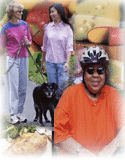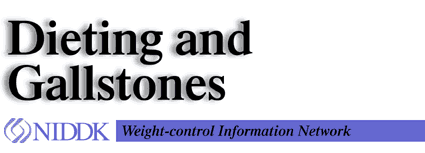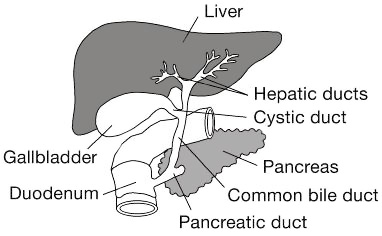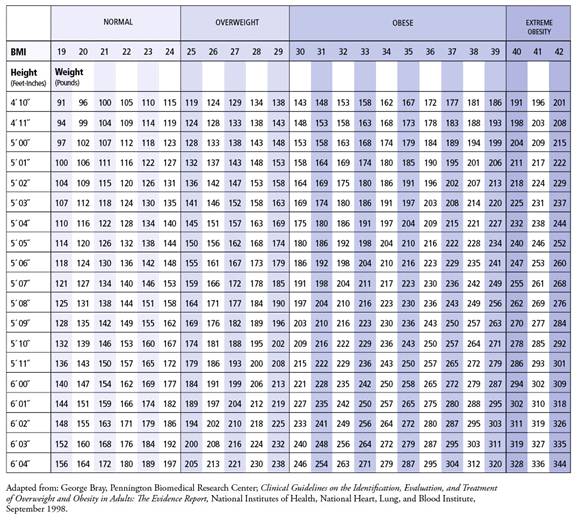
 |
 |



(326KB)

It is estimated that digestive diseases affect 60 to 70 million people in the United States. Gallbladder disease is one of the more common of these diseases. |
It is estimated that digestive diseases affect 60 to 70 million people in the United States. Gallbladder disease is one of the more common of these diseases. Experts estimate that as many as 20 million Americans have gallstones.
Most people with gallstones do not know that they have them and experience no symptoms. These people may have painless gallstones, or silent gallstones. Sometimes gallstones cause abdominal or back pain. These are called symptomatic gallstones. In rare cases, gallstones can cause serious health problems. Hundreds of thousands of hospitalizations and operations occur annually as a result of gallstones.
This fact sheet can help answer some of the questions you may have about gallstones:
|
| What are
gallstones? |
Gallstones are clusters of solid material that form in the gallbladder. The most common type is made mostly of cholesterol. Gallstones may occur as one large stone or as many small ones. They vary in size and may be as large as a golf ball or as small as a grain of sand.
Top
|
| What causes
gallstones to develop? |
 Gallstones develop in the gallbladder, a small pear-shaped organ located beneath the liver on the right side of the abdomen. The gallbladder is about 3 inches long and 1 inch wide at its thickest part. It stores and releases bile into the intestine to help digestion. Gallstones develop in the gallbladder, a small pear-shaped organ located beneath the liver on the right side of the abdomen. The gallbladder is about 3 inches long and 1 inch wide at its thickest part. It stores and releases bile into the intestine to help digestion.
Bile is a liquid made by the liver. It contains water, cholesterol, bile salts, fats, proteins, and bilirubin (a bile pigment). During digestion, the gallbladder contracts to release bile into the intestine, where the bile salts help to break down fat. Bile also dissolves excess cholesterol.
According to researchers, cholesterol gallstones may form in several ways, such as:
- When bile contains more cholesterol than it can dissolve.
- When there is too much bilirubin or other substance in the bile that causes cholesterol to form hard crystals.
- When there are not enough bile salts to break down fat.
- When the gallbladder does not contract and empty its bile regularly.
Top
|
| What are the
symptoms of gallstones? |
Some common symptoms of gallstones or gallstone attack include:
- Severe pain in the upper abdomen that starts suddenly and lasts from 30 minutes to many hours.
- Pain under the right shoulder or in the right shoulder blade.
- Nausea or vomiting.
- Indigestion after eating high-fat foods, such as fried foods or desserts.
Top
|
| Is obesity a risk
factor for gallstones? |
Obesity is a strong risk factor for gallstones, especially among women. People who are obese are more likely to have gallstones than people who are at a healthy weight. Obesity in adults can be defined using the body mass index (BMI), a tool that measures weight in relation to height. The table below shows how the BMI calculation works. A BMI of 18.5 to 24.9 refers to a healthy weight, a BMI of 25 to 29.9 refers to overweight, and a BMI of 30 or higher refers to obesity.
As BMI increases, the risk for developing gallstones also rises. Studies have shown that risk may triple in women who have a BMI greater than 32 compared to those with a BMI of 24 to 25. The risk may be seven times higher in women with a BMI above 45 than in those with a BMI below 24.
Researchers have found that people who are obese may produce high levels of cholesterol. This leads to the production of bile containing more cholesterol than it can dissolve. When this happens, gallstones can form. People who are obese may also have large gallbladders that do not empty normally or completely. Some studies have shown that men and women who carry fat around their midsections may be at a greater risk for developing gallstones than those who carry fat around their hips and thighs.
Table 1. Body Mass
Index

Top
|
Is weight-loss
dieting a risk factor for
gallstones?
People who are overweight are more likely to develop gallstones than people who are at a healthy weight. The risk for developing gallstones also increases with quick weight loss or a large weight loss. Gradual weight loss can lower the risk for obesity-related gallstones. |
Weight-loss dieting increases the risk of developing gallstones. People who lose a large amount of weight quickly are at greater risk than those who lose weight at a slower pace. Rapid weight loss may also cause silent gallstones (painless gallstones) to become symptomatic. Studies have shown that people who lose more than 3 pounds per week may have a greater risk of developing gallstones than those who lose weight at slower rates.
A very low-calorie diet (VLCD) allows a person who is obese to quickly lose a large amount of weight. VLCDs usually provide about 800 calories per day in food or liquid form, and are followed for 12 to 16 weeks under the supervision of a health care professional. Studies have shown that 10 to 25 percent of people on a VLCD developed gallstones. These gallstones were usually silent—they did not produce any symptoms. About one-third of the dieters who developed gallstones, however, did have symptoms and some of these required gallbladder surgery.
Experts believe weight-loss dieting may cause a shift in the balance of bile salts and cholesterol in the gallbladder. The cholesterol level is increased and the amount of bile salts is decreased. Following a diet too low in fat or going for long periods without eating (skipping breakfast, for example), a common practice among dieters, may also decrease gallbladder contractions. If the gallbladder does not contract often enough to empty out the bile, gallstones may form.
A drug called ursodiol that helps dissolve cholesterol in the bile may help prevent gallstones from developing during rapid weight loss. While ursodiol is not approved by the U.S. Food and Drug Administration (FDA) to prevent gallstones, its “off-label” use (the practice of prescribing medications for periods of time or for conditions not FDA-approved) has been shown to be effective and safe. If rapid weight loss is highly likely, you should consider talking with your health care provider about using ursodiol.
Top
|
| Is weight cycling a
risk factor for gallstones? |
Weight cycling, or losing and regaining weight repeatedly, may increase the risk of developing gallstones. People who weight cycle—especially with losses and gains of more than 10 pounds—have a higher risk for gallstones than people who lose weight and maintain their weight loss. Additionally, the more weight a person loses and regains during a cycle, the greater the risk of developing gallstones.
Why weight cycling is a risk factor for gallstones is unclear. The rise in cholesterol levels during the weight-loss phase of a weight cycle may be responsible. It is also thought that each cycle increases one’s risk for gallstones. However, further research is required to determine the exact link between weight loss and the risk for gallstones.
Top
|
| Is surgery to treat
obesity a risk factor for
gallstones? |
Gallstones are common among people who undergo bariatric surgery to lose weight. Bariatric surgery to reduce the size of the stomach or bypass parts of the digestive system is a weight-loss method for people who have a BMI above 40. This procedure is also an option for people who have a BMI above 35 with comorbid conditions such as diabetes and high blood pressure. Experts estimate that about one-third of patients who have bariatric surgery develop gallstones. The gallstones usually develop in the first few months after surgery and are symptomatic.
Top
|
| How can I safely
lose weight and decrease the risk of
gallstones? |
You can take several measures to decrease the risk of developing gallstones during weight loss. Losing weight gradually, instead of losing a large amount of weight quickly, lowers your risk. Depending on your starting weight, experts recommend losing weight at the rate of 1/2 to 2 pounds per week. Losing weight at this rate commonly occurs for up to 6 months. After 6 months, weight loss usually declines and weight stabilizes because individuals in lower weight groups use fewer calories (energy). You can also decrease the risk of gallstones associated with weight cycling by aiming for a modest weight loss that you can maintain. Even a loss of 5 to 10 percent of body weight over a period of 6 months or more can improve the health of an adult who is overweight or obese.
Your food choices can also affect your gallstone risk. Experts recommend including some fat in your diet to stimulate gallbladder contracting and emptying. Current recommendations indicate that 20 to 35 percent of your total calories should come from fat. Studies have also shown that diets high in fiber and calcium may reduce the risk of gallstone development.
Finally, regular physical activity is related to a lower risk for gallstones. Aim for approximately 60 minutes of moderate- to vigorous-intensity activity on most days of the week to manage your body weight and prevent unhealthy weight gain. To sustain weight loss, engage in at least 60 to 90 minutes of daily moderate-intensity physical activity.
Top
|
| What is the
treatment for gallstones? |
Silent gallstones are usually left alone and sometimes disappear on their own. Symptomatic gallstones are usually treated. The most common treatment is surgery to remove the gallbladder. This operation is called a cholecystectomy. In other cases, nonsurgical approaches—drugs—are used to dissolve the gallstones. Your health care professional can help determine which option is best for you.
Top
|
|
|
| Are the benefits of
weight loss greater than the risk of
getting gallstones? |
Although weight loss increases the risk of developing gallstones, obesity poses an even greater risk. In addition to gallstones, obesity is linked to many serious health problems, including:
- type 2 diabetes
- high blood pressure
- heart disease
- stroke
- certain types of cancer
- sleep apnea (when breathing stops for short periods during sleep)
- osteoarthritis (wearing away of the joints)
- fatty liver disease
For people who are obese, weight loss can lower the risk of developing some of these illnesses. Even a small weight loss of 10 percent of body weight over a period of 6 months can improve health and lower disease risk. In addition, weight loss may bring other benefits such as better mood, increased energy, and positive self-image.
If you are thinking about starting an eating and physical activity plan to lose weight, talk with your health care professional first. Together, you can discuss various eating and physical activity programs, your medical history, and the benefits and risks of losing weight, including the risk of developing gallstones.
Top
|
| Additional
Reading |
Clinical Guidelines on the Identification, Evaluation, and Treatment of Overweight and Obesity in Adults: The Evidence Report. September 1998. This National Heart, Lung, and Blood Institute report targets primary care practitioners and provides evidence for the effects of treatment on overweight and obesity.
Finding Your Way to a Healthier You: Based on the “Dietary Guidelines for Americans.” This brochure from the U.S. Department of Health and Human Services (DHHS) and the U.S. Department of Agriculture provides basic guidelines for eating a healthy diet and being physically active.
Gallstones. This fact sheet provides basic information about gallstones and treatment options. Published by the National Institute of Diabetes and Digestive and Kidney Diseases (NIDDK) and available through the National Digestive Diseases Information Clearinghouse, 2 Information Way, Bethesda, MD, 20892–3570, Tel: 1–800–891–5389.
Bariatric Surgery for Severe Obesity. This fact sheet provides basic information about bariatric surgery, including benefits and risks. Published by NIDDK and available through the Weight-control Information Network (WIN), 1 WIN Way, Bethesda, MD, 20892–3665, Tel: 1–877–946–4627.
Prescription Medications for the Treatment of Obesity. Information, including potential benefits and side-effects of current Food and Drug Administration-approved prescription weight-loss medications, is provided in this fact sheet. Published by NIDDK and available through WIN.
Weight Cycling. This fact sheet provides general information about weight cycling and associated health risks. Published by NIDDK and available through WIN.
Weight Loss for Life. Information about healthful weight loss as well as weight-loss program options is provided in this brochure. Published by NIDDK and available through WIN.
Top
|
|
|
|
|
Weight-control Information Network
1 WIN Way
Bethesda, MD 20892–3665
Phone: (202) 828–1025
Toll-free number: 1–877–946–4627
Fax: (202) 828–1028
Email: win@info.niddk.nih.gov
Internet: http://www.win.niddk.nih.gov
The Weight-control Information Network (WIN) is a service of the National Institute of Diabetes and Digestive and Kidney Diseases (NIDDK) of the National Institutes of Health, which is the Federal Government’s lead agency responsible for biomedical research on nutrition and obesity. Authorized by Congress (Public Law 103–43), WIN provides the general public, health professionals, the media, and Congress with up-to-date, science-based health information on weight control, obesity, physical activity, and related nutritional issues.
Publications produced by WIN are reviewed by both NIDDK scientists and outside experts. This publication was also reviewed by Jay Everhart, M.D., M.P.H., Chief, Epidemiology and Clinical Trials Branch, NIDDK; Van S. Hubbard, M.D., Ph.D., CAPT, USPHS, Director, Division of Nutrition Research Coordination, NIH; and Susan Z. Yanvoski, M.D., Director, Obesity and Eating Disorders Program and Co-Director, Office of Obesity Research, NIDDK.
This publication is not copyrighted. WIN encourages users of this fact sheet to duplicate and distribute as many copies as desired.
Top
|


|
U.S. DEPARTMENT OF HEALTH AND HUMAN SERVICES
National Institutes of Health
NIH Publication No. 02-3677
August 2008
|
|
|



 Gallstones develop in the gallbladder, a small pear-shaped organ located beneath the liver on the right side of the abdomen. The gallbladder is about 3 inches long and 1 inch wide at its thickest part. It stores and releases bile into the intestine to help digestion.
Gallstones develop in the gallbladder, a small pear-shaped organ located beneath the liver on the right side of the abdomen. The gallbladder is about 3 inches long and 1 inch wide at its thickest part. It stores and releases bile into the intestine to help digestion. 